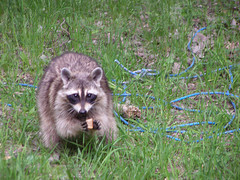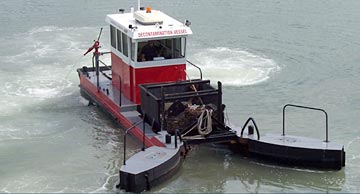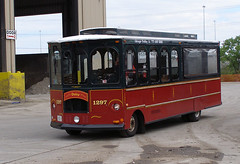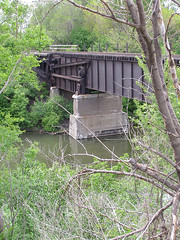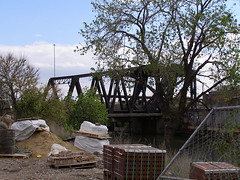Last week the suburban Pioneer Press ran a whole series of articles about the Des Plaines River.
So I decided to take the Blue Line out to the nearest forest preserve to see the springtime wildflowers along the Des Plaines.
As soon as I entered Chevalier Woods I was met by a raccoon sitting in the midst of a garbage can in broad daylight. When I stopped to watch it humped reluctantly away, but then a whole crowd of white tailed deer gathered round expectantly. They were scraggy and half-molted into summer coats, but definitely not underfed. As I watched, a woman stepped out of a car with a jar of crackers and enticed a few nervous does to take a bite.

Hiking down a forest path I soon came to the sluggish little river. The Des Plaines has to be one of the least glamorous of all the rivers of America. Although its lower reaches had a dramatic part to play in history, its upper part is consigned to travel through suburban sprawl on the western edge of Chicago. From Salt Creek up to its source in southern Wisconsin it is a slow stream, with a drop of only six inches per mile. Its waters are murky with natural tannins and clay, but mostly tainted by runoff from parking lots and fertilized lawns, and fouled by stormwater overflows of sewage.
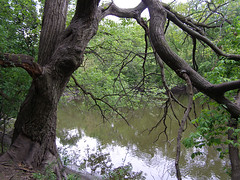
The original French name of the river, des Pleines, is thought to refer to its tendency to flood, like any river through flat country. But flooding has become more of its habit in the last decades as its basin is increasingly developed and paved over. The river once had wetlands to escape to when it rose, but many have been filled in, and the river constrained by levees, which only increase the speed and height of the water downstream.
Adding to its indignity, many of the forests in the preserves on its banks are in a shameful state. Large areas are overrun by invasive species such as buckthorn and garlic mustard, creating dense thickets of weedy brush that are of limited interest to wildlife and visitors alike.
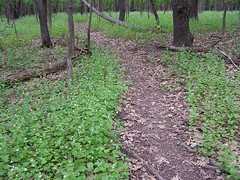
Volunteer groups such as the North Branch Restoration Project have had some success in reestablishing native plants in some areas, but in other areas the invaders have taken over. Many of northern Illinois' native ecosystems were dependent on fire, both on the prairies and in the riparian woodlands, and years of fire suppression have only allowed the non-native plants to get the upper hand.
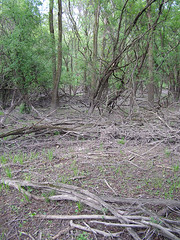
In wandering for several hours in the woods, I saw a countless tiny white flowers of the garlic mustard, but only a few other wildflowers. Some wood violets, a few stands of mayapple, and later on a single trillium and trout lily (neither blooming right now). There were wild onions which gave Chicago its name, but not many other discoveries. In comparison with the lush flowers and growth of other Illinois forests, this was a desert.

At least there were lots of animals and critters to see. Down by the river baby ducklings and goslings were peeping about. One short space of the trail was bouncing with baby grasshoppers hardly 1/4 inch long. And when I finally left, there was another of these attractive raccoons munching on croutons from some lost lunch dumped in the grass by the parking lot. It wasn't interested in the salad, but seemed to enjoy picking up the bread with its paws clumsily to take a bite.
